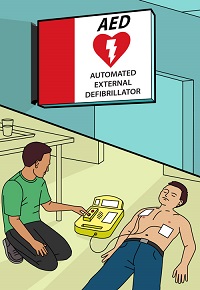How Devices In Public Places Can Restart Hearts

Sudden cardiac arrest occurs when the heart suddenly and unexpectedly stops pumping blood. It can happen to anyone, at any time, and signs include sudden collapse and immediate loss of consciousness.
Unlike heart attacks, which are caused by a blockage in an artery to the heart, sudden cardiac arrest is caused when the heart’s electrical system malfunctions. This produces abnormal heart rhythms (called arrhythmias) that make the heart unable to pump blood, explains Oscar Tovar-Calderón, M.D., a medical officer at the U.S. Food and Drug Administration.
If cardiac arrest does occur, rapid treatment with a medical device called an automated external defibrillator, or “AED” for short, can be life-saving.
“Defibrillation is a time-sensitive issue,” adds Tovar-Calderón. The probability of survival decreases by 7% to 10% for every minute that a victim stays in a life-threatening arrhythmia.
What is an AED and how are these devices regulated?
An AED is a type of computerized defibrillator that automatically analyzes the heart rhythm in people who are experiencing cardiac arrest—and when appropriate, delivers an electrical shock to the heart to restore its normal rhythm.
The U.S. Food and Drug Administration regulates AEDs as medical devices and evaluates them for safety and effectiveness before they can be marketed. As part of this regulatory oversight, the FDA closely monitors reports of device malfunctions from both consumers and manufacturers themselves.
While the FDA regulates AEDs as medical devices, the agency does not regulate the resuscitation guidelines for the use of these devices. Visit the website of the American Heart Association to learn exactly how and when to use an AED.
Where can you find AEDs?
You can find AEDs in many public places, including offices, schools, shopping malls, grocery stores and airports.
In general, AEDs require a prescription to be used at home.
Some people with underlying cardiac conditions can be at a higher risk of sudden cardiac arrest. Your healthcare provider can tell you if a home AED is something you should consider.
How do AEDs work?
An AED system includes an AED device, battery, pad electrodes, and if applicable, an adapter. AEDs use electrical shocks to restore the heart to its normal rhythm. The devices give verbal instructions to users.
This is how they work:
- The user turns on the AED and follows the voice prompts. Some devices turn on automatically when the user opens the lid.
- The user attaches two sticky pads with sensors (called electrodes) on the chest of the person in cardiac arrest.
- The electrodes send information about the person’s heart rhythm to a processor in the AED, which then analyzes the rhythm to find out whether an electric shock is needed.
- If a defibrillation shock is needed, the AED uses the voice prompts to instruct when to press a button to deliver the shock. In some devices, the voice prompts announce that a shock is going to be delivered and the AED delivers the shock without intervention by the user.
Do you need to be trained to use an AED—and where can you find classes?
In an emergency situation, always call 9-1-1 first. A 9-1-1 operator can provide directions on how you can help someone experiencing sudden cardiac arrest. AEDs are not difficult to use, but training in the use of AEDs is highly recommended. This training—in connection with CPR training—is offered by major health organizations such as the American Heart Association and the American Red Cross, as well as from a number of private companies. Some training is available online.
Classes teach such skills as how to recognize the signs of a sudden cardiac arrest, when to alert emergency medical services, how to do CPR, and how to use an AED.
Some people may be afraid to use an AED because they’re concerned that something may go wrong and they might be sued. However, most states’ Good Samaritan laws and the Federal Cardiac Arrest Survival Act (Public Law 106-505) provide some protection for bystanders who respond to emergencies.
How can you report device problems to the FDA?
If you have problems while using an AED—or if a device injures you—the FDA encourages you to file a voluntary report online at MedWatch, the FDA Safety Information and Adverse Event Reporting program.
If you have questions about a device, or want to talk with someone, call the FDA Consumer Complaint Coordinator who works with your state. Phone numbers are listed online.
This article appears on the FDA’s Consumer Updates page, which features the latest on all FDA-regulated products.
Story Credit: http://www.satprnews.com/2017/02/15/how-devices-in-public-places-can-restart-hearts/


